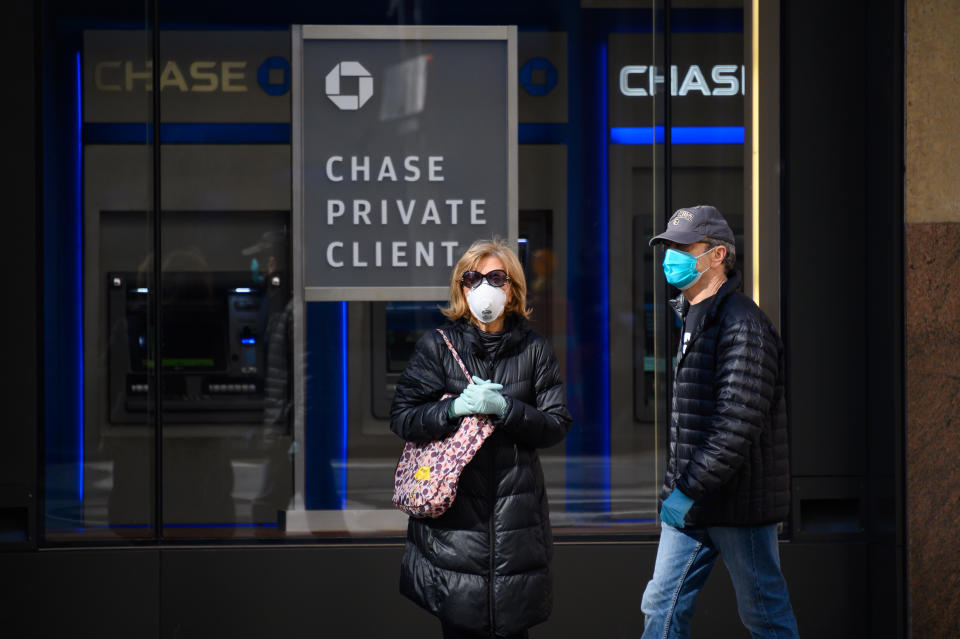Banks were not prepared for flood of small business coronavirus loan applications
The Trump administration’s emergency $349 billion Paycheck Protection Program to help small businesses cover their payroll costs was set to roll out on Friday April 3, with banks accepting applications from businesses slammed by coronavirus. (Applicants must have fewer than 500 employees.)
All week leading up to the start date, President Trump, Treasury Secretary Steven Mnuchin, and other senior administration officials talked up the program and how much it will help small businesses in dire need.
But when the starting light turned green, banks weren’t prepared to handle the flood of applications. (Banks were supposed to begin processing applications at midnight on Thursday night.)
By Friday morning, a number of banks were either not accepting loans yet, or having issues with their loan application pages. That’s despite Mnuchin having declared that the small businesses approved for the loans would “get the money the same day.”
It was already clear by Thursday that banks weren’t going to be ready for Friday and hadn’t yet received critical guidance on how the process would work. The official SBA (Small Business Administration) guidelines for the loan process were still being adjusted as late as Thursday night.
JPMorgan Chase (JPM) on Thursday night sent notices to customers that warned, “Financial institutions like ours are still awaiting guidance from the SBA and the U.S. Treasury. As a result, Chase will most likely not be able to start accepting applications on Friday, April 3rd, as we had hoped.”
Richard Hunt, CEO of the Consumer Bankers Association, said in a statement on Thursday night, “Having just received guidance outlining how to implement a $349 billion program literally hours before it starts, we would ask for everyone to be patient as banks move heaven and earth to get a system in place and running to help America’s small businesses and the millions of men and women who work at them.”
By early Friday morning, SBA loan application pages at Chase, Citi (C), and Wells Fargo (WFC) were not up and running.

Once Bank of America (BAC) did get its portal up and running on Friday, it quickly received more than 10,000 applications in the first hour, but faced a firestorm from customers that were turned away because they did not have outstanding loans with the bank.
Companies with long-held checking accounts with Bank of America were unable to submit an application online, spurring a stream of complaints directed at the bank's Twitter account.
To add to all those issues, Bank of America’s application page experienced outages on Friday. Chase finally got its portal up around 1pm on Friday.
By mid-afternoon on Friday, Bank of America said it had granted over 58,000 client loans, and received an estimated $6 billion in applications.
One business owner who has a children's clothing store in South Florida got rejected by Bank of America and tweeted that it was “appalling.” She told Yahoo Finance that she had taken loans out from Bank of America before, but because those loans were paid off, she also was not eligible.
Bank of America told Yahoo Finance in a statement Friday that its "near-term priority" are its nearly 1 million small business borrowing clients: "As the administration has made clear, going to your current lending bank is the fastest route to completion."
By Saturday afternoon, Bank of America had received more than $26 billion in applications from about 122,000 clients. The bank also clarified that businesses without existing Bank of America loans would be eligible as long as they do not have a borrowing relationship with another bank.
Bank of America may be prioritizing customers with outstanding loans because the bank would have the most updated data on the borrower, easing bank compliance with Know Your Customer (KYC) and Anti-Money Laundering (AML) regulations while the bank underwrites the PPP loan.
The SBA guidance out today on who qualifies for the Paycheck Protection Program is a mess. Despite the plain text of the statute Congress passed, today’s guidance may exclude many churches & religious nonprofits. @SBAJovita & Treasury must fix this problem now
— Josh Hawley (@HawleyMO) April 3, 2020
Earlier in the week, Treasury Secretary Mnuchin, after pressure from the banks, raised the interest rate small businesses will have to pay on the loans to 1% from 0.5%.
Frank Sorrentino, CEO of Connect One Bank, said on Yahoo Finance on Friday morning that his bank has been accepting applications online with no problems, “We are just waiting for the final set of rules to be reconciled with the program itself, and then we are ready to go.”
Sorrentino added that the new interest rate of 1% was not a huge factor for his bank. “The interest rate is not impacting our decision... Yes, I would like to see a somewhat higher interest rate because ultimately we’re going to bear the brunt of any losses, but at the end of the day, this program is critically important fur our small businesses, for their employees, for the community, and we’ve got to do everything we can to get this done and not worry about the economics of this transaction.”
—
Daniel Roberts is an editor-at-large at Yahoo Finance. Follow him on Twitter at @readDanwrite.
Brian Cheung is a reporter at Yahoo Finance covering the Fed, economics, and banking. Follow him on Twitter @bcheungz.
Read more on the economic impact of coronavirus:
SF Fed chief: Central bank will do ‘whatever it takes’ to support the economy
St. Louis Fed chief: Coronavirus economic effects will be ‘unparalleled’
Chef Tom Colicchio on coronavirus: Restaurants should stay closed, even for takeout
Chef Marcus Samuelsson on coronavirus: ‘Where restaurants go away, so goes all small business’
Nike, Lululemon say they learned lessons from coronavirus closures in China they can apply to U.S.
Coronavirus puts 'extreme pressure' on all three pillars of Disney's business